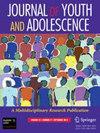Gaming for Self-Searching? A Three-Wave Longitudinal Investigation on the Correlations and Predictions Among Self-Concept Clarity, Player-Avatar Identification, and Internet Gaming Disorder.
IF 3.6
1区 心理学
Q1 PSYCHOLOGY, DEVELOPMENTAL
引用次数: 0
Abstract
Existing research on the associations among self-concept clarity, player-avatar identification, and Internet gaming disorder has largely relied on cross-sectional designs, and the findings were inconsistent. This three-wave longitudinal study examined whether self-concept clarity and player-avatar identification jointly and reciprocally relate to Internet gaming disorder symptoms among emerging adults using both general and random-intercept cross-lagged panel model. Participants were 877 role-playing gamers (Mage = 19.81, SDage = 1.33; 54.80% female) with a baseline and two follow-up surveys (at six and twelve months). Results of both general and random-intercept cross-lagged panel models indicated that, contrary to the hypotheses, self-concept clarity did not predict Internet gaming disorder symptoms nor vice versa, and neither self-concept clarity nor player-avatar identification showed significant indirect effects on Internet gaming disorder symptoms. Although player-avatar identification maintained a positive association with Internet gaming disorder symptoms at the between-person level, it showed no prospective effects at the within-person level. The present study did not provide empirical support for any hypothesized prospective mechanisms among the measured variables. Still, its findings suggest that domain-specific cognitive factors, such as player-avatar identification, may be informative for monitoring Internet gaming disorder risk and highlight the need to support self-concept development during emerging adulthood.自我搜索游戏?自我概念清晰、玩家-虚拟身份认同与网络游戏障碍相关性及预测的三波纵向调查
现有的关于自我概念清晰度、玩家角色识别和网络游戏障碍之间关系的研究主要依赖于横断面设计,研究结果并不一致。本研究采用一般和随机截点交叉滞后面板模型,考察了自我概念清晰度和玩家-虚拟形象识别是否与新兴成人网络游戏障碍症状相互关联。参与者是877名角色扮演游戏玩家(Mage = 19.81, SDage = 1.33, 54.80%为女性),并进行了基线和两次随访调查(分别在6个月和12个月)。一般和随机截距交叉滞后面板模型的结果表明,与假设相反,自我概念清晰度不能预测网络游戏障碍症状,反之亦然,自我概念清晰度和玩家-化身识别都没有对网络游戏障碍症状产生显著的间接影响。尽管在人际水平上,玩家-虚拟角色识别与网络游戏障碍症状保持正相关,但在人际水平上,它没有显示出预期的影响。本研究并没有为测量变量之间的任何假设的预期机制提供实证支持。尽管如此,研究结果表明,特定领域的认知因素,如玩家角色识别,可能对监测网络游戏障碍风险有帮助,并强调了在成年初期支持自我概念发展的必要性。
本文章由计算机程序翻译,如有差异,请以英文原文为准。
求助全文
约1分钟内获得全文
求助全文
来源期刊

Journal of Youth and Adolescence
PSYCHOLOGY, DEVELOPMENTAL-
CiteScore
8.20
自引率
6.10%
发文量
155
期刊介绍:
Journal of Youth and Adolescence provides a single, high-level medium of communication for psychologists, psychiatrists, biologists, criminologists, educators, and researchers in many other allied disciplines who address the subject of youth and adolescence. The journal publishes quantitative analyses, theoretical papers, and comprehensive review articles. The journal especially welcomes empirically rigorous papers that take policy implications seriously. Research need not have been designed to address policy needs, but manuscripts must address implications for the manner society formally (e.g., through laws, policies or regulations) or informally (e.g., through parents, peers, and social institutions) responds to the period of youth and adolescence.
 求助内容:
求助内容: 应助结果提醒方式:
应助结果提醒方式:


